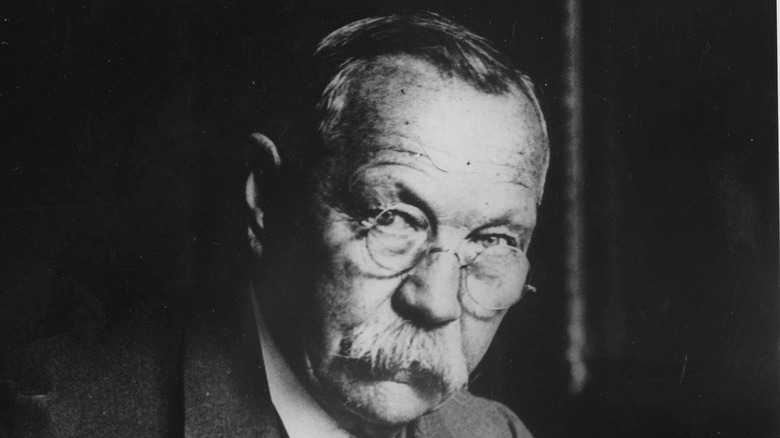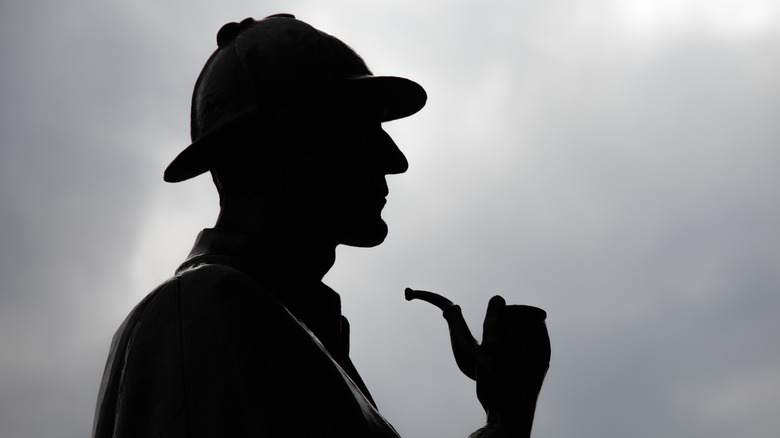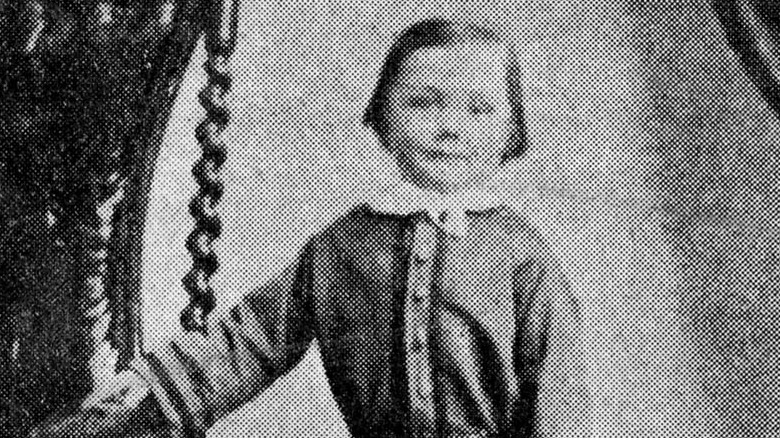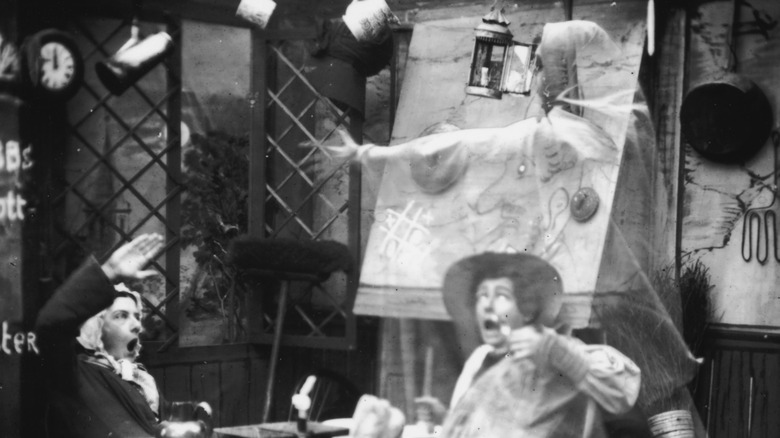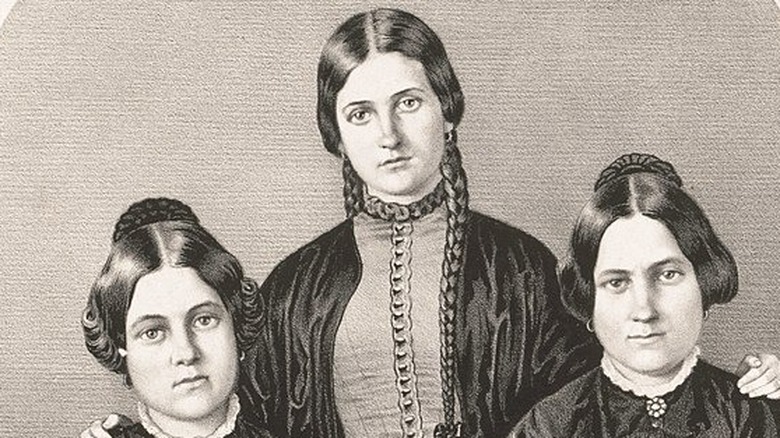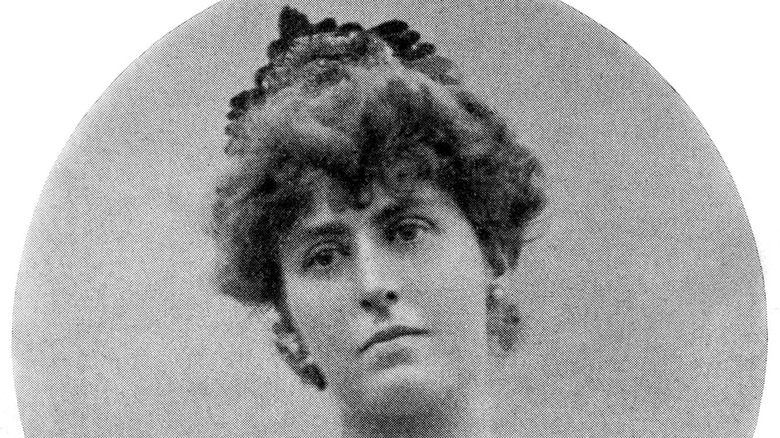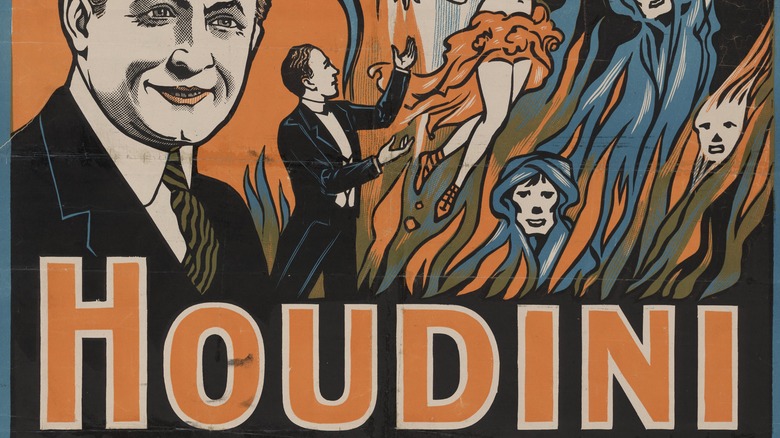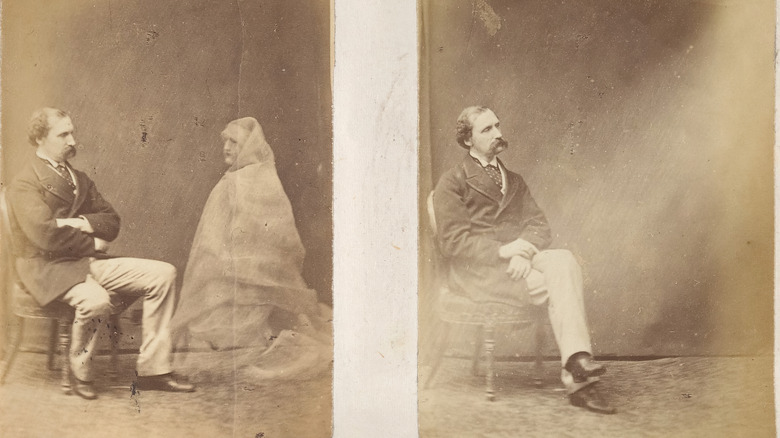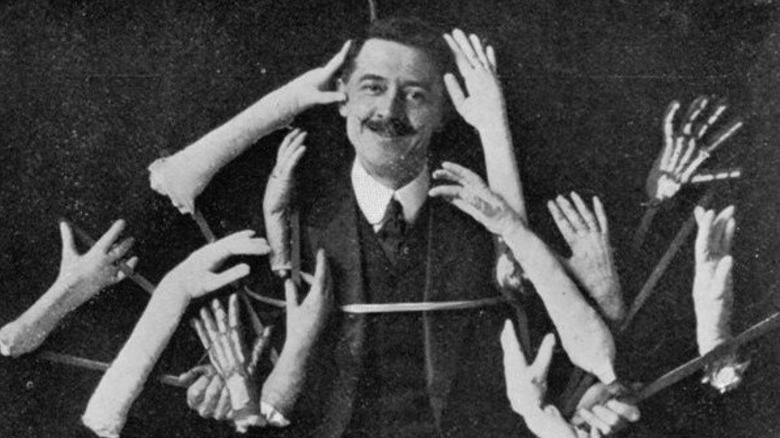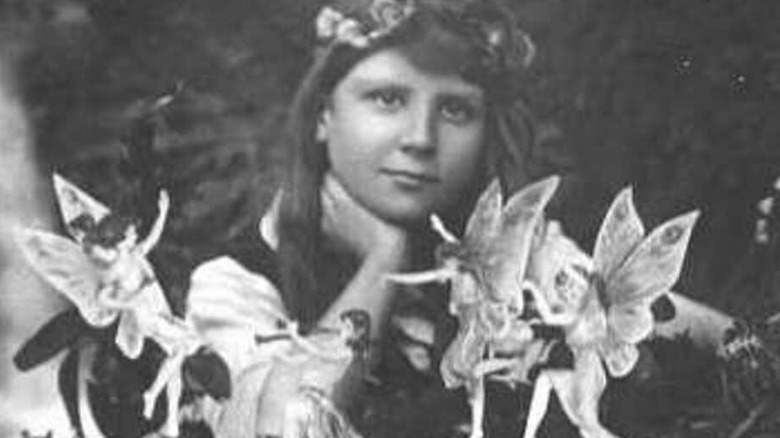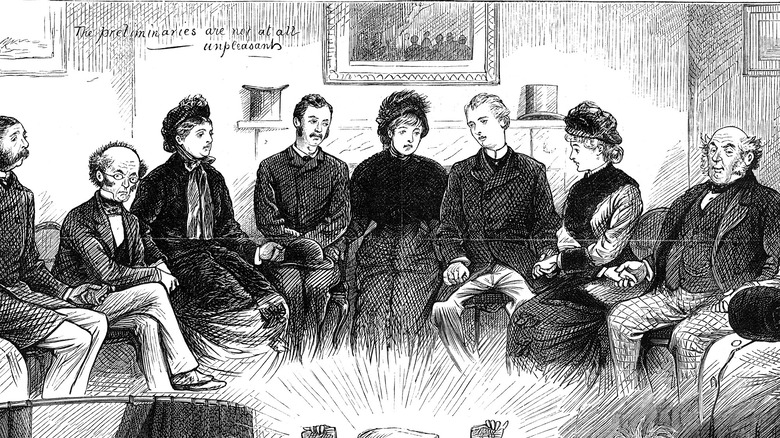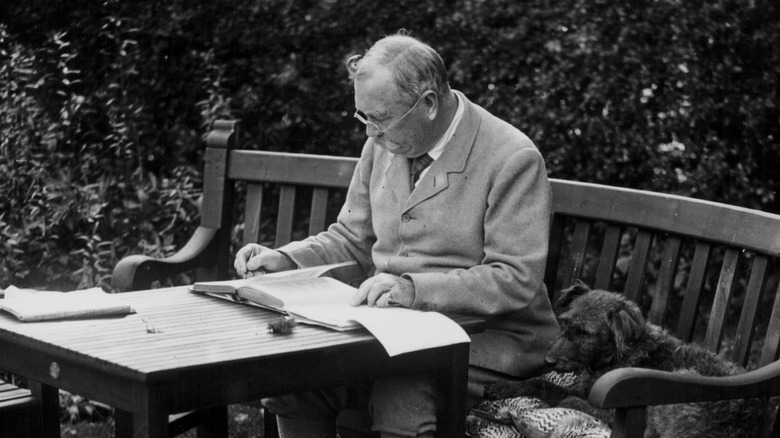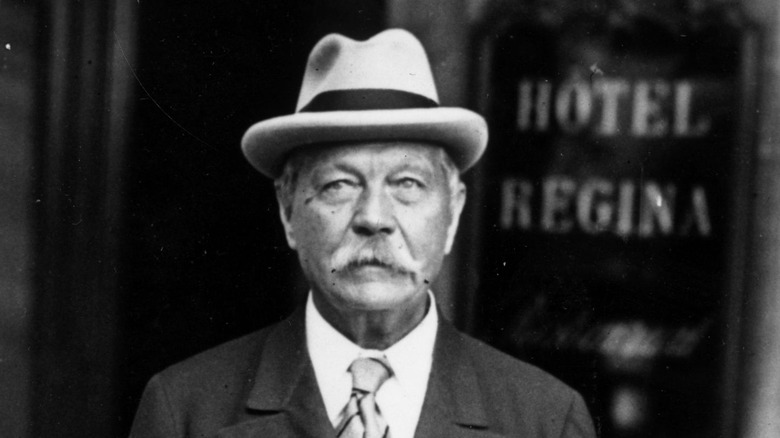The Bizarre Beliefs Of Arthur Conan Doyle Explained
Sherlock Holmes has remained among the most beloved literary figures since his first appearance on the page in 1887. With the possible exception of Mr. Spock, the consulting detective is perhaps the purest embodiment of dedication to logical reason in fiction. His creator, Arthur Conan Doyle, was in many ways his opposite, believing in many supernatural and spiritual forces.
Conan Doyle was a devout follower of a relatively new movement: spiritualism. As stated by Roger Luckhurst for the British Library, the 19th century is often thought of as a period of embracing scientific advancement, but Victorian England also experienced a "period of deep and sustained religious revival."
From his fervent belief that his friend, the famous escape artist Harry Houdini, had "psychic powers," to publishing papers on the existence of fairies, the author was about as far from the ever-rational Sherlock Holmes as possible. As noted by the New York Times, Conan Doyle was one of the most famous converts to spiritualism and, although he is best known today for his work as a crime novelist, he devoted much of his life to attempting to persuade others to believe in the supernatural.
Rationalism in Sherlock Holmes
In Sherlock Holmes, Arthur Conan Doyle created a character whose deductive techniques were far ahead of their time. Writer Laurie King explained to NPR that, "The tools that he used in the late 19th century were very modern. If you look at his forensic techniques, his investigative tools, they are things that are daily used by police departments around the world. In the Victorian era they were cutting [edge], now they are the basis of what we do."
Despite Conan Doyle's devotion to evangelical spiritualism, he never put his own beliefs into Sherlock Holmes. The character remains an avowed skeptic throughout his many adventures. In "The Hound of the Baskervilles," Holmes reacts with shock that a "trained man of science" would believe in the supernatural. Similarly, in "The Adventure of the Sussex Vampire," Holmes rejects the idea of monsters and magic outright, saying, "The world is big enough for us. No ghosts need apply."
Conan Doyle never introduced mystical elements to the world of Sherlock Holmes. As noted in "Sherlock Holmes and The Ritual of Reason," some of the most famous Sherlock Holmes stories depict a seemingly supernatural entity causing havoc, which is then revealed through Holmes' scientific powers of deduction to be the result of human crimes.
While Conan Doyle allowed the world of his fiction to adhere to science and logic, his beliefs about the real world were very different.
Childhood ghosts and new religions
Arthur Conan Doyle was raised a Roman Catholic, but began to doubt his faith at Jesuit school. According to "Sir Arthur Conan Doyle: Spiritualism and 'New Religions'," he couldn't reconcile doctrine such as immaculate conception with his own, "scientific desire for truth" and "intellectual self-respect." He was also deeply disturbed that anyone outside of the church would be damned.
As a student at the University of Edinburgh, Conan Doyle considered himself an agnostic. During this time, his beliefs most closely aligned with those of his future creation's, relying on observation and deduction to guide him. However, he continued to research religious beliefs.
As reflected in the first Sherlock Holmes novel, "A Study in Scarlet," Conan Doyle was particularly interested in Mormonism (though his depiction of Mormon history was likely influenced by "sensationalist authors"). "A Study in Scarlet" also contains references to the belief system that he would ultimately follow for the rest of his life –- spiritualism.
An occult society
While Arthur Conan Doyle's beliefs are often surprising to modern readers, particularly since he is most famous for creating one of literature's most devoted rationalists, a fascination with the supernatural became more and more common during his lifetime.
In the Victorian era, there was a thriving occult revival in England. As stated by historian Patricia Clarke, via "Fragile Spectres: How Women Of Victorian Britain Used The Occult And Spiritualist Movement To Create Autonomy," followers of the spiritualist movement believed, "that it was possible to unleash the powers of spirituality by communication with the spirit world. It embraced a belief in the continuity of personality after death and that people with psychic gifts ... could facilitate communication."
By the time that Conan Doyle found spiritualism, it was already thriving. In 1893, he joined the Society for Psychical Research. As noted by the Arthur Conan Doyle estate, many respected people were already involved, from scientists to politicians.
Although his interest in spiritualism started years earlier, many have connected the tragic death of his son in 1918 with Conan Doyle's passion for attempting to communicate with the dead. While this was not the initial cause of his interest, his personal losses, coupled with the hundreds of thousands of British men killed in World War I, made him a fierce advocate for the spiritualist movement. He would become the most well-known and influential believer in spiritualism.
Arthur Conan Doyle and the Fox sisters
One of the things that drew Arthur Conan Doyle to spiritualism was that, unlike many religions, it promised evidence. He said, "The subject of psychical research is one upon which I have thought more, and been slower to form my opinion about, than upon any other subject whatever." (via the Arthur Conan Doyle estate).
The apparent evidence of an afterlife provided by the Fox sisters played a huge part in making "modern spiritualism" an international movement. As explained by professor and author Donald Simanek, the three Fox sisters came to fame after claiming they could communicate with spirits using a system of first, "taps and knocks, automatic writing, and later even voice communication, as the spirit took control of one of the girls." Their instant success prompted many copycat mediums, who also charged money in exchange for talking to the dead. While there were skeptics, many others believed them.
In 1888, one of the Fox sisters, Margaret, confessed to an audience that they had been faking their abilities from the beginning. She even demonstrated the method that they had used to create the mysterious attributed to spirits –- famously including cracking their toe joints under their long skirts.
One might think that admitting such a hoax would damage spiritualism, but many of its biggest advocates accepted their abilities were fake. Among these was Conan Doyle, who stated that nothing the Fox sisters could say, "would in the least change my opinion, nor would it that of any one else who had become profoundly convinced that there is an occult influence connecting us with an invisible world."
Jean and Phineas
Arthur Conan Doyle's passionate belief in the supernatural was shared by his wife, Jean. And, as noted by The Guardian, she wasn't just a believer.
Jean became a medium. Her primary method was automatic writing, which was popular in Victorian England. As explained by modern magician Derren Brown, "mediums would take a piece of chalk and a slate, and they'd put the end of the chalk against the slate and they would allow their hand to write. The idea was the hand was moving outside of their own conscious awareness and that it was a spirit channeling through them, and could give messages for the people at the séance."
Jean claimed to be able to communicate with a spirit called Phineas, who lived with the Doyles. The couple took this very seriously. As stated by Christopher Sandford (via The Guardian) the things Phineas wanted were very conveniently also what Jean wanted.
Arthur Conan Doyle and Harry Houdini
Harry Houdini was an acclaimed magician, escape artist, and skeptic. Arthur Conan Doyle was a famous author and devout believer. They were some of the most popular celebrities of the age, and for a while, unlikely friends.
In 1922, however, the Conan Doyles held a private séance, in which Jean Conan Doyle claimed that she would be able to contact Houdini's beloved mother from beyond the grave, using her preferred method of automatic writing. According to The Guardian, Jean created a 15-page message, supposedly channeled directly from Houdini's mother. While the Conan Doyles initially thought Houdini was "deeply moved," he soon after publicly declared that the séance had been a hoax. While the long message had been written in perfectly grammatically correct English, his mother spoke very little English. As noted by Fox, the message began with a cross, while both Houdini and his mother were Jewish.
Houdini, who had already suspected that mediums were frauds, was now convinced. The friendship crumbled and Houdini became a lifelong skeptic with a productive career debunking mediums.
Arthur Conan Doyle believed in ghost photos
Another staple of spiritualism was spirit photography, or photographs that appeared to have ghostly figures. Arthur Conan Doyle was a full believer in these pictures, and the spirits they supposedly captured.
Dr. Martyn Jolly, author of "Faces of the Living Dead: the Belief in Spirit Photography," explains that Arthur Conan Doyle first contacted popular British "medium photographer" William Hope with the hope of capturing an image of his son, who had died during World War I. Hope obliged, photographing Conan Doyle in his studio, while two self-proclaimed mediums touched the camera. Sure enough, an image was produced that seemed to have another face in it. Doyle stated, "It is very possible that the whole picture, which has a general, but not very exact, resemblance to my son, was conveyed onto the plate from some existing picture. However that may be, it was most certainly supernormal, and not due to any manipulation or fraud."
Dr. Wilmar's camera
Spiritualists like Arthur Conan Doyle knew it was possible to fake supernatural activity, but believers hoped that closely observing the photographs being taken and controlling the way they were developed would prevent hoaxes. In 1921, magician William Marriott attempted to demonstrate to Conan Doyle that even under the strongest scrutiny it was possible to pull off a hoax.
Marriott, known onstage as Dr. Wilmar, was a magician who specialized in investigating mediums and exposing the tricks they used to make people believe. As reported in 1910 (via Past Paper) Marriott was particularly interested in spirit photography, and showing how the seemingly miraculous results could be reproduced using tricks. Marriott did not say outright that he believed all mediums were frauds, but he did confirm that he had proven over 95% of those he had met to be lying. On one notable occasion, Marriott caught an apparent apparition, and when the lights were turned on, it was revealed to be the medium in a costume.
As reported by the BBC, while being closely observed, Marriott took two photographs of Conan Doyle. Everyone confirmed that the photographs were taken and developed in a typical way, but thanks to Marriott's sleight of hand, the photos appeared to have a mysterious translucent figure and dancing fairies.
While Conan Doyle admitted that it was possible to fool him, he claimed that the length of the fingers of the photographer would reveal if they had genuine powers. "A conjurer has certain physical characteristics" such as "long, nervous artistic fingers," he said, whereas mediums who could produce real spirit photographs had "short, thick and work stained" hands.
Arthur Conan Doyle believed in fairies
The inclusion of fairies in William Marriott's photo of Arthur Conan Doyle was not random. Though Conan Doyle took Marriott's successful fakes in stride, and even kept the photograph of himself as a souvenir, he took the existence of fairies very seriously.
In 1917, a pair of cousins, one 16 and one 10, showed the world photographs they had taken of themselves apparently surrounded by fairies. Photography experts at the time assured the public that the photos had been developed normally. However, as noted by Donald Simanek, the fairies had "a flat cut-out appearance" and seem more like paper dolls fixed to bushes and branches than moving, three-dimensional creatures -– which was confirmed when the cousins eventually confessed to having faked the images in 1982.
Conan Doyle was confident that the photographs were real. He wrote extensively about them, even releasing a book called, "The Coming of Fairies."
Attending a veiled seance
In 1919, Arthur Conan Doyle attended a small, private event alongside a detective, a coroner, and other spiritualists. Modern psychologist and magician Matthew Thomkins identifies this event as pivotal to understanding Conan Doyle's desire to believe in the impossible. The event was hosted by magician Percy Thomas Tibbles (known onstage as P.T. Selbit), who claimed that after years of debunking mediums, he had found someone who could really talk to the dead.
In truth, Tibbles had recruited the help of another illusionist named Mary Wynter –- her specialty was mimicking the apparently supernatural acts of mediums. During the show, Wynter wore a veil and performed a séance. Each member of the small audience had been told to bring a personal item. These had been locked inside a box, and when Wynter held it, she was able to describe each thing in vivid detail. Finally she summoned a cloud of mysterious fog, which appeared to look like an elderly woman.
After the event, Wynter and Tibbles explained the methods they had used to deceive their audience: an earpiece concealed under Wynter's veil so an assistant could tell her each item in the box, and gauze painted with phosphorescent paint and manipulated by an acrobat.
Despite the explanation, Conan Doyle refused to believe it had been fake. Instead, he decided that the two performers were lying to hide their magical abilities.
Writing about spiritualism
Arthur Conan Doyle, though certainly best known for his detective stories, was a highly prolific writer. The Arthur Conan Doyle Encyclopedia, a website that hosts the author's works, lists more than 300 short stories and novels, as well as more than 1,200 nonfiction essays and articles. Many of these were about spiritualism.
"Killed Holmes," Conan Doyle wrote in his diary in 1893 (via the BBC). After years of writing the famous character, Conan Doyle had had enough of crime stories, and his rationalist protagonist. In "The Final Problem," Sherlock Holmes was killed while on a case. Fans, who some say wore black mourning bands, canceled their subscriptions to the magazine that published the Holmes stories and wrote furious letters to Conan Doyle. In 1901, Conan Doyle caved to the pressure, and brought the consulting detective back from his fictional grave.
Despite the fervour his work stirred up in readers, Conan Doyle stated that he would be happy to give up his literary career if in return more people would believe in spiritualism. Even after Holmes was brought back, Conan Doyle devoted as much energy as possible to spreading his beliefs, calling his crusade, "the most important thing in the world" (via the Arthur Conan Doyle Estate). In 1926, Doyle published a book called "The History of Spiritualism," in which he described the movement as "the most important in the history of the world since the Christ episode."
Arthur Conan Doyle uses deduction
Arthur Conan Doyle and his obsession with the supernatural might seem like the opposite of the logical consulting detective he created, but in 1925 he would receive a desperate message urging him to solve a murder.
As detailed by Margalit Fox, author of "Conan Doyle for the Defense" (via Publishers Weekly), in 1908 a wealthy, elderly woman was murdered and her brooch stolen. The authorities believed the murderer was German Jewish immigrant Oscar Slater, who had pawned a similar brooch shortly after the robbery. Although it was ultimately proved to be a different brooch, the police continued to pursue a case against Slater. In 1909, Slater was sent to "Scotland's gulag" for a life sentence of hard labor. In 1925, Slater was able to sneak a tiny message out of the fortress, hidden in the fake teeth of a man who had been paroled. The message was to Conan Doyle.
Conan Doyle used a method much like Sherlock Holmes, carefully gathering all the facts and determining areas where something was amiss. By 1927, Slater was free. Although Conan Doyle only publicly argued that Slater was innocent, in private he wrote that he believed he had also discovered the identity of the true killer.
